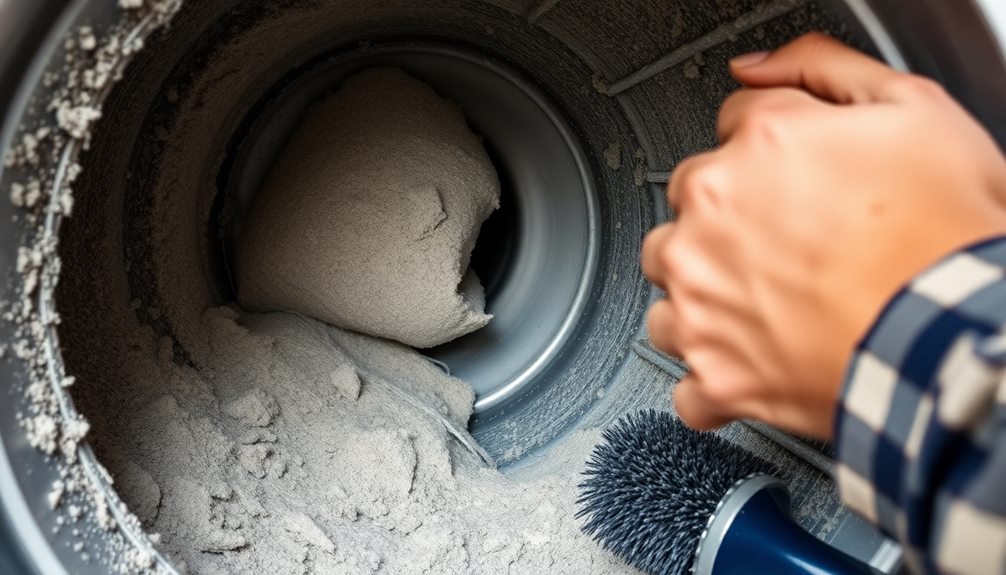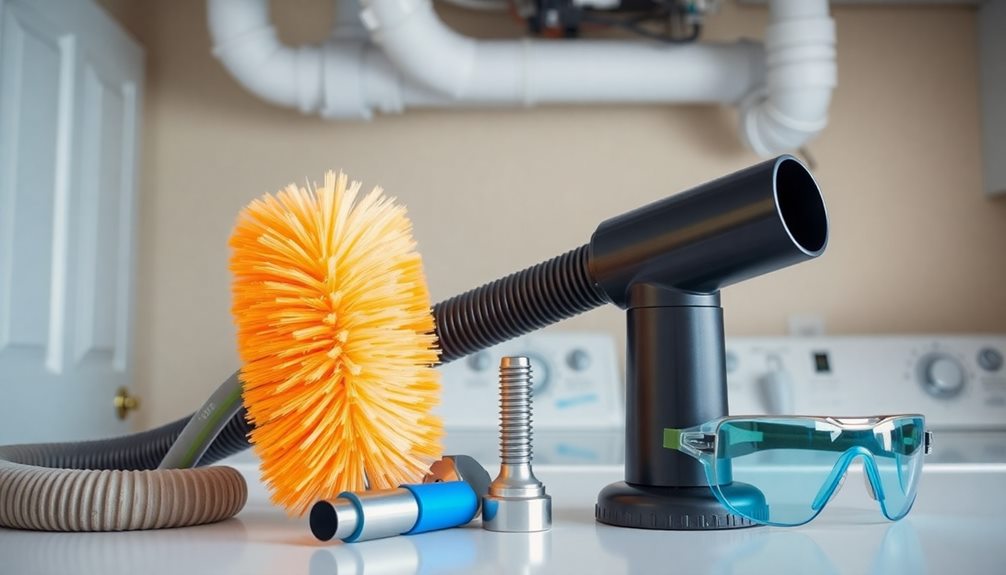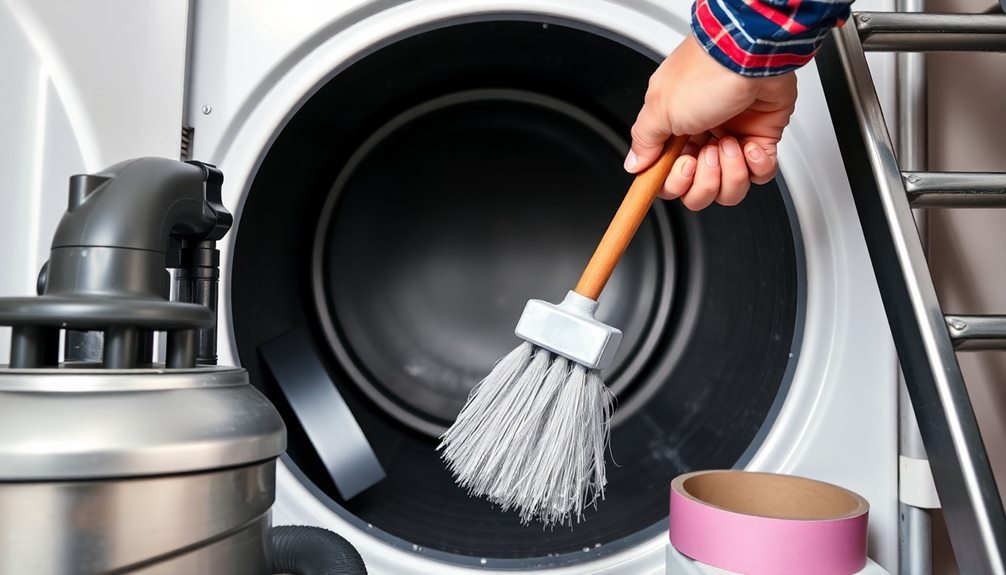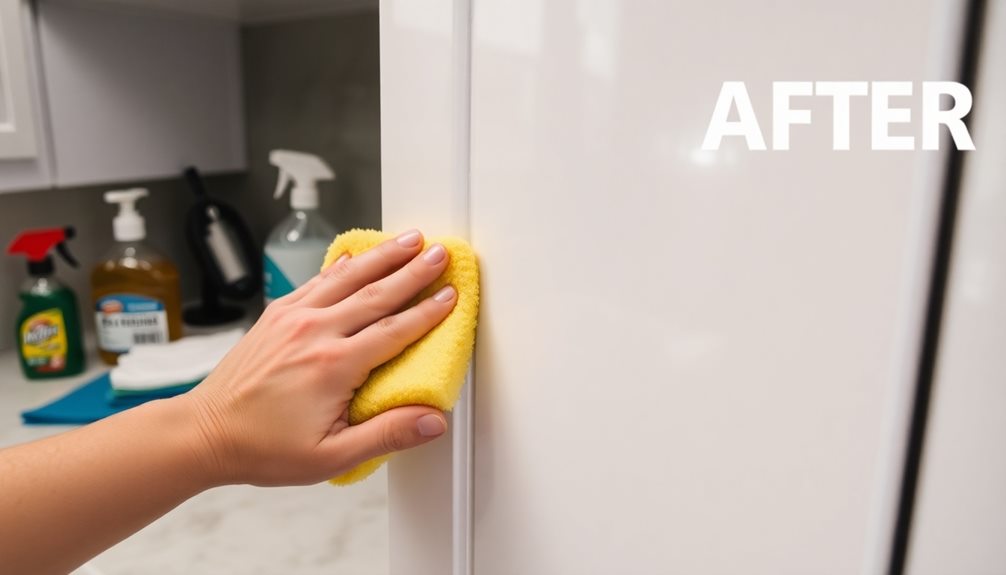Yes, you can clean your dryer vent yourself, and it's crucial for safety and efficiency. Start by unplugging your dryer and removing the vent cover using a screwdriver. Use a vacuum with a hose attachment to clear lint from the dryer opening and vent pipe. For stubborn debris, a specialized cleaning brush is handy. After cleaning, inspect the ducts for damage before reassembling everything. Don't forget to clean the lint filter after each load and aim for a thorough vent cleaning every 3 to 6 months. Want to guarantee you implement all the best practices? There's more to discover!
Key Takeaways
- Yes, you can clean your dryer vent yourself using basic tools like a vacuum and specialized brushes.
- Always unplug the dryer and turn off the gas supply before starting the cleaning process.
- Remove the vent cover to access the ductwork for thorough cleaning and inspection.
- Regularly clean the lint filter after each load to prevent buildup and enhance airflow.
- Schedule professional cleaning every few years for a comprehensive inspection and to ensure optimal performance.
Importance of Dryer Vent Cleaning
Cleaning your dryer vent isn't just a chore; it's an essential step in keeping your home safe and efficient. Clogged dryer vents pose significant fire hazards, being responsible for about 15,500 fires each year.
By taking the time to clean your dryer vent, you're not only protecting your home but also improving dryer efficiency. A clean vent can reduce drying times by up to 30%, allowing you to save both time and energy costs.
Moreover, regular dryer vent cleaning can save you up to $300 annually on energy bills, thanks to improved airflow and reduced drying cycles. You'll also extend your appliance's lifespan, preventing costly repairs or replacements in the future.
Additionally, neglecting to clean your vents can lead to lint buildup, dust, and debris accumulating in your home, which negatively impacts indoor air quality and can trigger respiratory issues or allergies.
In short, cleaning your dryer vent is vital for safety, cost savings, and maintaining a healthy living environment.
Signs of a Clogged Vent

A clogged dryer vent can lead to several noticeable signs that shouldn't be ignored. If you find your clothes taking longer than usual to dry, requiring multiple cycles, it's likely time for some cleaning.
An excessively hot exterior on your dryer after a cycle is another red flag, often caused by overheating due to lint buildup blocking airflow.
You might also notice a burning smell while the dryer runs, which is a serious concern stemming from overheated lint; this indicates an urgent need for cleaning to prevent fire hazards.
Additionally, keep an eye out for visible lint accumulation around the lint trap, vent opening, or dryer flap. This buildup can impede proper drying and signal a blockage that requires attention.
If you've noticed increased humidity in your laundry area, it could be due to a clogged vent, potentially leading to moisture-related issues and mold growth in your home.
Addressing these signs promptly will help guarantee a clean dryer vent and a safer, more efficient drying process.
Don't wait for the situation to worsen; take action as soon as you spot these indicators.
Required Tools for Cleaning

To tackle dryer vent cleaning effectively, you'll need a few essential tools at your disposal. These tools will help you remove lint and debris, ensuring your dryer functions efficiently and safely.
Here's a quick reference table for the tools you'll need:
| Tool | Purpose |
|---|---|
| Vacuum Cleaner | Use with a hose attachment to clear lint from the dryer and ductwork inside. |
| Vent Cover | You'll need to remove this to access the ductwork. |
| Cleaning Brush | A specialized brush helps dislodge stubborn lint and debris inside the ducts. |
| Screwdriver | Essential for removing the vent cover and accessing hidden areas. |
| Flashlight | Helps you inspect dark spaces for blockages and lint buildup. |
| Safety Gloves | Protects your hands from sharp edges and irritating lint. |
With these tools, you're set to conduct a thorough cleaning of your dryer vent. Make sure to check the lint trap as well; clearing it regularly reduces blockage. Preparing your workspace with these items will make the process smoother and more efficient. Happy cleaning!
Step-by-Step Cleaning Process

With your tools gathered and the dryer safely unplugged, you're ready to start the cleaning process. If you have a gas dryer, don't forget to turn off the gas supply before you move the dryer away from the wall for better access.
Begin by removing the vent cover using a screwdriver, allowing you to reach the duct and exhaust system.
Next, grab your vacuum cleaner with the hose attachment. Use it to remove lint buildup from the dryer opening and vent pipe, making sure you reach deep into the ducts for a thorough clean.
After that, insert the vent brush into the duct. Rotate it as you scrub the inside walls to dislodge any stubborn debris.
Once you've cleaned the vent, inspect the ducts for any damage. If everything looks good, reattach the ductwork securely.
Maintenance and Prevention Tips

How can you affirm your dryer runs efficiently and safely? By following some essential maintenance and prevention tips, you can keep your dryer vent in top shape and reduce fire hazards. Here's what you can do:
- Regularly clean the lint filter after each load to prevent lint buildup and improve airflow.
- Schedule a detailed dryer vent cleaning every 3 to 6 months, especially if you use your dryer frequently or have pets.
- Inspect the dryer vent and ductwork at least once a year for blockages or damage to confirm proper airflow.
- Use dryer sheets or wool dryer balls to lessen static cling, which can help minimize lint accumulation.
Additionally, consider hiring professional cleaning services every few years for a thorough inspection. They can access hard-to-reach areas and confirm a detailed cleaning, further enhancing your dryer's performance.
Frequently Asked Questions
Can I Clean Out My Dryer Vent Myself?
Yes, you can absolutely clean out your dryer vent yourself. With basic tools, you'll tackle lint buildup effectively, improve airflow, and reduce drying times. Regular maintenance helps guarantee your dryer runs efficiently and safely.
Is It Better to Clean Dryer Vents DIY or Professional?
Deciding between DIY and professional dryer vent cleaning depends on your comfort level and tools. If you're confident and equipped, DIY saves money. Otherwise, professionals guarantee a thorough job, especially with complex duct systems. Choose wisely!
Is It Better to Clean Dryer Vents From Inside or Outside?
Imagine your dryer overheating and nearly catching fire. It's essential to clean vents from both inside and outside. This dual approach tackles clogs effectively, ensuring safety, efficiency, and prolonging your dryer's lifespan. Don't skip it!
Can I Use a Leaf Blower to Clean My Dryer Vent?
Yes, you can use a leaf blower to clean your dryer vent. Just make sure the vent's accessible, wear safety gear, and remember that it might not reach all bends—consider using a vent brush for deeper cleaning.
Conclusion
Cleaning your dryer vent yourself is not just a chore; it's essential for safety and efficiency. By tackling this task, you're not only reducing fire risks but also improving your dryer's performance. If you've noticed longer drying times or a musty smell, it's a clear sign that your vent needs attention. With the right tools and a little effort, you can keep your home safe and your clothes fresh. So, roll up your sleeves and get to it!










